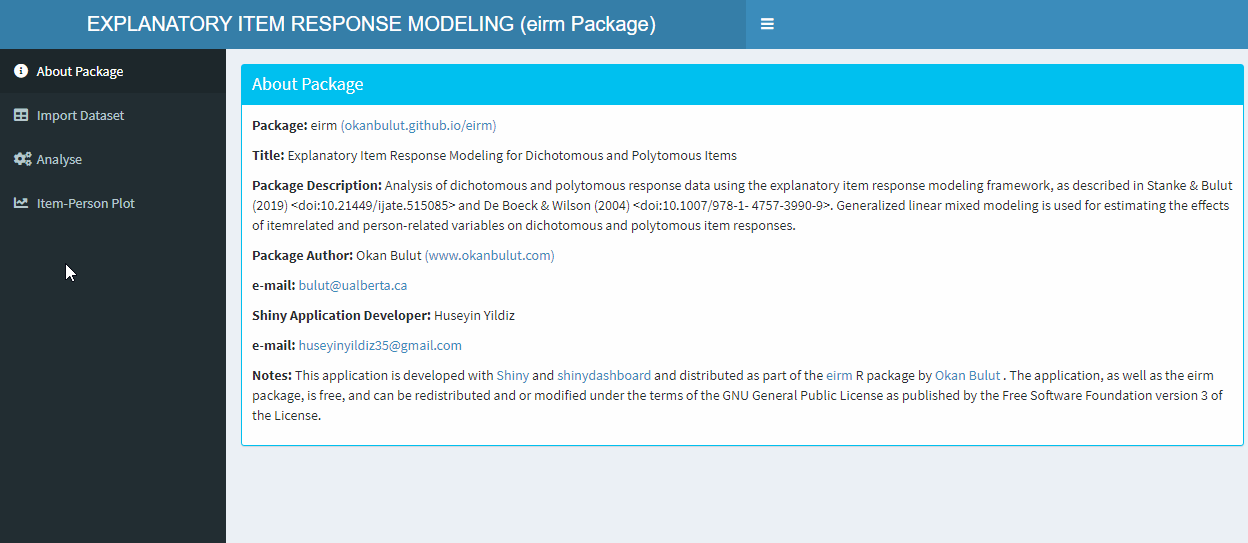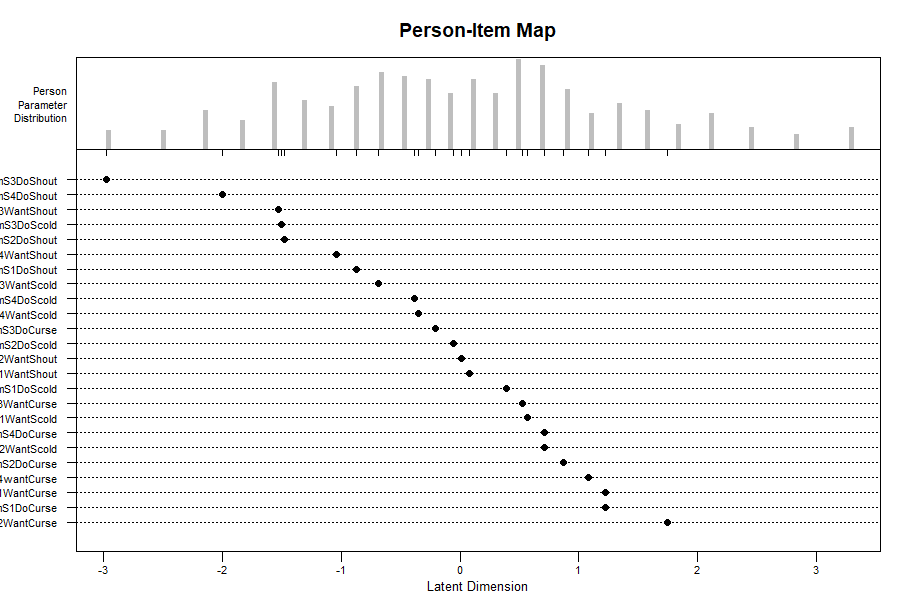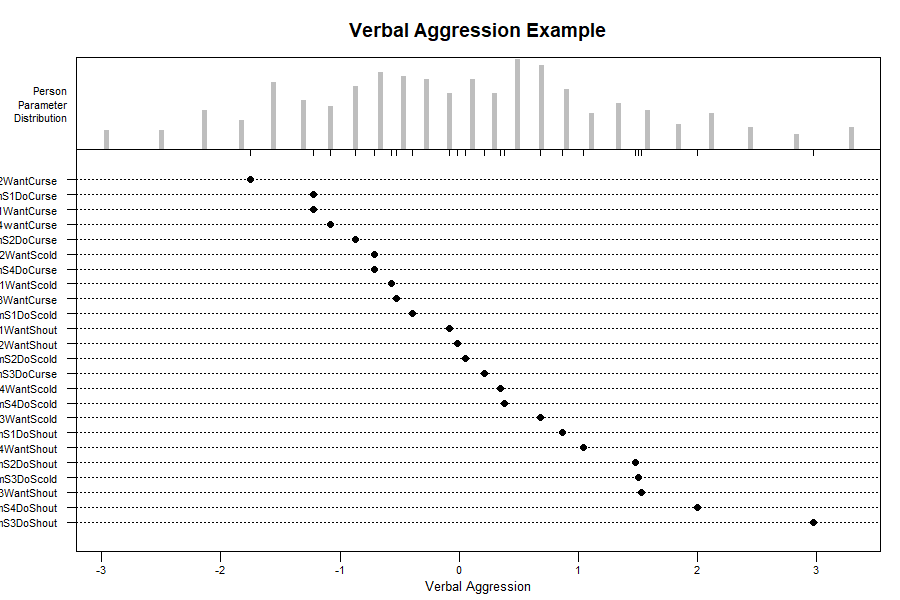The eirm package, which is essentially a wrapper around the lme4 and
blme packages, provides a simple and easy-to-use set of tools for
preparing data, estimating explanatory item response theory (IRT)
models, extracting model output, and visualizing model results. The
primary goal of eirm is to streamline the processes of data
preparation, model estimation, and model interpretation for various
explanatory IRT models. The functions in the eirm package enable
researchers to leverage the power of lme4 and blme for the
estimation of explanatory IRT models while providing additional helper
functions and visualization tools to better interpret the model output.
The latest version on CRAN can be installed by:
install.packages("eirm")The development version can be installed by:
devtools::install_github(repo = "okanbulut/eirm")Note: If you download the Github version and see the following
output on your console (or something similar), please choose 3: None
from this list. You can simply type 3 in your R console and hit
“enter”.
Downloading GitHub repo okanbulut/eirm@master
These packages have more recent versions available.
Which would you like to update?
1: All
2: CRAN packages only
3: None
4: Rcpp (1.0.1 -> 1.0.3 ) [CRAN]
5: RcppEigen (0.3.3.5.0 -> 0.3.3.7.0) [CRAN]
6: plyr (1.8.4 -> 1.8.5 ) [CRAN]
7: stringi (1.4.3 -> 1.4.5 ) [CRAN]
Enter one or more numbers, or an empty line to skip updates:If this also fails, you can run the following lines all together and
select 3: None by typing 3 in your R console:
Sys.setenv(R_REMOTES_NO_ERRORS_FROM_WARNINGS=TRUE)
devtools::install_github(repo = "okanbulut/eirm")To cite eirm in your work, please use the following APA-style
citation:
Bulut, O. (2021). eirm: Explanatory item response modeling for dichotomous and polytomous item responses, R package version 0.4. doi: 10.5281/zenodo.4556285 Available from https://CRAN.R-project.org/package=eirm.
Bulut, O., Gorgun, G., & Yildirim-Erbasli, S. N. (2021). Estimating explanatory extensions of dichotomous and polytomous Rasch models: The eirm package in R. Psych, 3(3), 308-321. doi:10.3390/psych3030023
You can also print(citation("eirm"), bibtex = TRUE) to view the
citations in BibTeX format.
You can use eirmShiny() to open the Shiny GUI for the eirm function:
I plan to expand the Shiny GUI with additional features in the future. Please let me know if you have any suggestions or comments.
Please visit https://okanbulut.github.io/eirm for documentation and vignettes. For questions about the functionality, you may either contact me via email or also file an issue.
On the package website, you can
access two vignettes demonstrating how to use eirm for:
- Estimating dichotomous explanatory IRT models with binary data (e.g., 0 = Wrong, 1 = Right)
- Estimating polytomous explanatory IRT models with ordinal data (e.g., 1 = No, 2 = Maybe, 3 = Yes)
To demonstrate how the eirm() function works with a quick example, we
will estimate the Rasch model (i.e., a fully descriptive model). The
following example shows how to estimate item parameters for the verbal
aggression data set (see ?VerbAgg for further details). A preview of
the VerbAgg data set is shown below:
data("VerbAgg")
head(VerbAgg)
#> Anger Gender item resp id btype situ mode r2
#> 1 20 M S1WantCurse no 1 curse other want N
#> 2 11 M S1WantCurse no 2 curse other want N
#> 3 17 F S1WantCurse perhaps 3 curse other want Y
#> 4 21 F S1WantCurse perhaps 4 curse other want Y
#> 5 17 F S1WantCurse perhaps 5 curse other want Y
#> 6 21 F S1WantCurse yes 6 curse other want YTo estimate the Rasch model, a regression-like formula must be defined:
formula = "r2 ~ -1 + item + (1|id)". In the formula,
r2is the variable for dichotomous item responses-1removes the intercept from the model and yields parameter estimates for all items in the data set. With1(instead of-1), an intercept representing the parameter of the first item and relative parameters for the remaining items (i.e., distance from the parameter of the first item) would be estimated.itemis the variable representing item IDs in the data set(1|id)refers to the random effects for persons represented by theidcolumn in the data set.
The output for the Rasch model is shown below:
mod1 <- eirm(formula = "r2 ~ -1 + item + (1|id)", data = VerbAgg)
print(mod1)
EIRM formula: "r2 ~ -1 + item + (1|id)"
Number of persons: 316
Number of observations: 7584
Number of predictors: 24
Parameter Estimates:
Easiness S.E. z-value p-value
itemS1WantCurse 1.22107 0.1611 7.5794 3.470e-14
itemS1WantScold 0.56477 0.1525 3.7032 2.129e-04
itemS1WantShout 0.08009 0.1505 0.5323 5.945e-01
itemS2WantCurse 1.74879 0.1738 10.0632 8.035e-24
itemS2WantScold 0.70772 0.1538 4.6020 4.184e-06
itemS2WantShout 0.01172 0.1504 0.0779 9.379e-01
itemS3WantCurse 0.52947 0.1522 3.4777 5.057e-04
itemS3WantScold -0.68637 0.1542 -4.4506 8.564e-06
itemS3WantShout -1.52694 0.1692 -9.0222 1.843e-19
itemS4wantCurse 1.08204 0.1587 6.8193 9.151e-12
itemS4WantScold -0.34938 0.1515 -2.3062 2.110e-02
itemS4WantShout -1.04402 0.1591 -6.5628 5.280e-11
itemS1DoCurse 1.22107 0.1611 7.5794 3.470e-14
itemS1DoScold 0.38962 0.1514 2.5739 1.006e-02
itemS1DoShout -0.87122 0.1565 -5.5680 2.576e-08
itemS2DoCurse 0.87264 0.1557 5.6063 2.067e-08
itemS2DoScold -0.05668 0.1505 -0.3766 7.065e-01
itemS2DoShout -1.48186 0.1681 -8.8152 1.195e-18
itemS3DoCurse -0.21104 0.1509 -1.3988 1.619e-01
itemS3DoScold -1.50431 0.1687 -8.9189 4.709e-19
itemS3DoShout -2.97500 0.2334 -12.7483 3.186e-37
itemS4DoCurse 0.70772 0.1538 4.6020 4.184e-06
itemS4DoScold -0.38422 0.1517 -2.5328 1.132e-02
itemS4DoShout -1.99947 0.1839 -10.8750 1.516e-27
Note: The estimated parameters above represent 'easiness'.
Use difficulty = TRUE to get difficulty parameters.By default, the eirm function returns the easiness parameters
because the function uses a regression model parameterization where
positive parameters indicate positive association with the dependent
variable. In order to print the difficulty parameters (instead of
easiness), print(mod1, difficulty = TRUE) must be used:
print(mod1, difficulty = TRUE)
Parameter Estimates:
Difficulty S.E. z-value p-value
itemS1WantCurse -1.22107 0.1611 7.5794 3.470e-14
itemS1WantScold -0.56477 0.1525 3.7032 2.129e-04
itemS1WantShout -0.08009 0.1505 0.5323 5.945e-01
itemS2WantCurse -1.74879 0.1738 10.0632 8.035e-24
itemS2WantScold -0.70772 0.1538 4.6020 4.184e-06
itemS2WantShout -0.01172 0.1504 0.0779 9.379e-01
itemS3WantCurse -0.52947 0.1522 3.4777 5.057e-04
itemS3WantScold 0.68637 0.1542 -4.4506 8.564e-06
itemS3WantShout 1.52694 0.1692 -9.0222 1.843e-19
itemS4wantCurse -1.08204 0.1587 6.8193 9.151e-12
itemS4WantScold 0.34938 0.1515 -2.3062 2.110e-02
itemS4WantShout 1.04402 0.1591 -6.5628 5.280e-11
itemS1DoCurse -1.22107 0.1611 7.5794 3.470e-14
itemS1DoScold -0.38962 0.1514 2.5739 1.006e-02
itemS1DoShout 0.87122 0.1565 -5.5680 2.576e-08
itemS2DoCurse -0.87264 0.1557 5.6063 2.067e-08
itemS2DoScold 0.05668 0.1505 -0.3766 7.065e-01
itemS2DoShout 1.48186 0.1681 -8.8152 1.195e-18
itemS3DoCurse 0.21104 0.1509 -1.3988 1.619e-01
itemS3DoScold 1.50431 0.1687 -8.9189 4.709e-19
itemS3DoShout 2.97500 0.2334 -12.7483 3.186e-37
itemS4DoCurse -0.70772 0.1538 4.6020 4.184e-06
itemS4DoScold 0.38422 0.1517 -2.5328 1.132e-02
itemS4DoShout 1.99947 0.1839 -10.8750 1.516e-27
Note: The estimated parameters above represent 'difficulty'.The mod1 object is essentially a glmerMod-class object from the
lme4 package (Bates, Maechler, Bolker, & Walker
(2015)). All glmerMod
results for the estimated model can seen with mod1$model. For example,
estimated random effects for persons (i.e., theta estimates) can be
obtained using:
theta <- ranef(mod1$model)$idTo visualize the results, we can create an item-person map using
plot(mod1), which returns the following plot. Note that this plot is a
modified version of the plotPImap function from the eRm package
(Mair, Hatzinger, Maier, Rusch, & Debelak,
2020).
plot(mod1)Aesthetic elements such as axis labels and plot title can be added to
the plot. For example, the following code updates the x-axis label and
the main plot title (see ?plot.eirm for further details).
plot(mod1, difficulty = TRUE, main = "Verbal Aggression Example",
latdim = "Verbal Aggression")which will show the difficulty parameters (instead of easiness), change the main title above the plot, and change the x-axis – the name for the latent trait being measured.





